Visitors won’t recognise this former ‘Pearl of the Orient’
By Julie Miller
I’m sipping a negroni at a rooftop bar, watching distant neon illuminations come to life as the sun dips over the horizon. Thirty-seven storeys below, honking traffic jams herald another chaotic Friday night as revellers head out on the town, searching for the next good meal or watering hole to wash away the stresses of the working week.
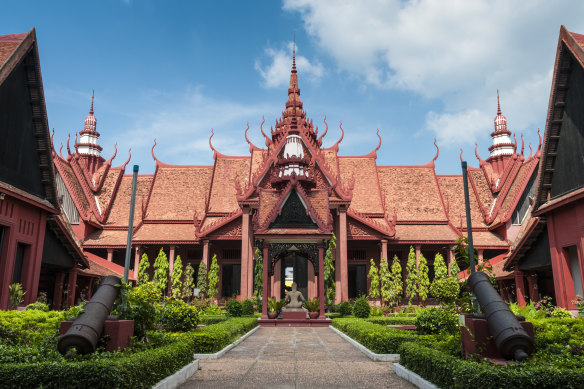
The National Museum.Credit: Getty Images
This scene, surrounded by a sea of skyscrapers competing for airspace, is one familiar to many bustling South-East Asian cities. But this is Phnom Penh – once the “country cousin” of the region, a formerly sleepy town emerging from decades of civil war and unrest, and a city historically ignored by mainstream tourism.
While in terms of visitor numbers it still plays second fiddle to Siem Reap – gateway to the incredible World Heritage-listed temples of Angkor – Cambodia’s capital has certainly come a long way since my first visit in 2009. Back then, the tallest buildings were the beautiful two- and three-storey French colonial mansions that once earned it the moniker the “Pearl of the Orient”. All the tourist activity took place along the riverfront, where the lively FCC (Foreign Correspondents’ Club) was the place to herald the night.
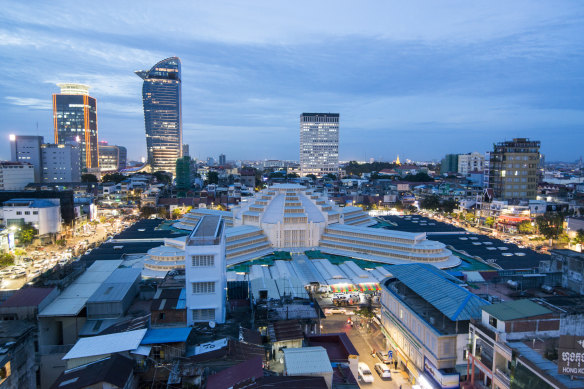
The art deco central market in Phnom Penh. Credit: iStock
Today, the city has been reshaped as more than 50 skyscrapers of 40 floors or more pierce the sky. At least half of the city’s historically significant buildings have been razed, replaced by modern condos, high-end hotels and shopping malls. The FCC is under wraps, with an unknown reopening date, while strolling past the shops facing the Mekong is an impossibility, due to massive SUVs parked illegally on the footpath.
For a bird’s-eye view of this rapidly evolving and increasingly chaotic city, there’s no better spot than from the Sora skybar at Rosewood Phnom Penh, a luxury hotel located in the top 14 floors of Phnom Penh’s first skyscraper, Vattanac Capital Tower. Built in 2012 to resemble a mythical naga serpent (guardians of treasure in Hindu mythology), this tower – the tallest building in the city between 2014 and 2022 – is now dwarfed by at least 10 other buildings, the tallest being the Morgan EnMaison 2 condo complex, which rises to 53 floors on the Mekong riverbank.
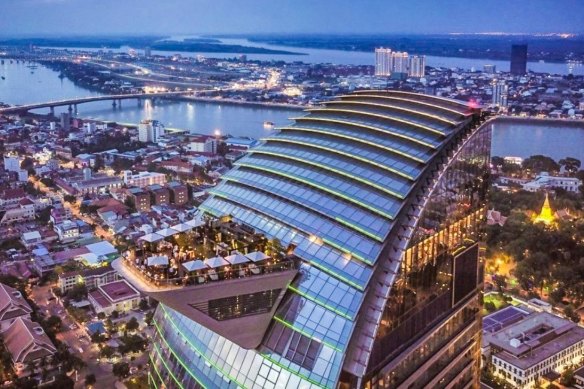
The Vattanac Capital Tower, with a height of 188 metres, is now dwarfed by at least 10 other buildings.
I’m curious to check out the area with the most recent construction, a former wetland on the Bassac River known as Diamond Island, now a concrete jungle of Chinese-funded and patronised casinos and condominiums. An inclusion in my three-night stay at Rosewood Phnom Penh is a complimentary four-hour remork, or electric tuk-tuk, tour of the city; but when I ask my driver to first take me to this area, he seems a little perplexed. Western tourists, he hints, tend not to visit the casino hub; it’s very much a Chinese realm, and never the twain shall meet.
I’m adamant, but while touring through this area is fascinating, I find little to lure me to linger, particularly during daylight hours. It’s shiny, new, but ultimately soulless – with the only colour being the cyberpunk neons that light up the buildings after dark.
With my curiosity about modern Phnom Penh satisfied, my driver reverts to the standard tour inclusions: the No.1 attraction in the city, the Royal Palace; the National Museum of Cambodia; the art deco Central Market; and Wat Phnom, a white pagoda dating to the late 14th century that graces a hill (“phnom” in the Khmer language), built to house four Buddha statues and one of Vishnu, found alongside the Mekong River by a woman named Penh.
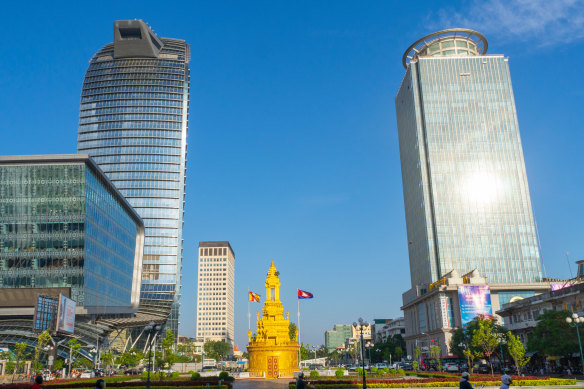
The old and the new in Phnom Penh.Credit: Adobe Stock
Nearby, in the so-called French Quarter, are some of the city’s most beautiful and increasingly rare French colonial buildings: the still operational post office, the ornate but sadly decaying Manolis Hotel, and the original c.1892 police headquarters, abandoned and in a sad state of disrepair.
There are also many gracious vestiges of the colonial past on the streets behind the Royal Palace, where some of the best shopping in the city can be found. A stroll along Street 240 finds a mix of boutiques selling Fairtrade items, homeware stores, day spas and the wonderful The Gallerist contemporary art gallery, which provides a platform for emerging and established Cambodia artists including Siem Reap master Theam, and Chan Dany, whose delicate works made from pencil shavings give the illusion of intricate embroidery.
Sadly, the quirky Street 240 and a half – where the ARTillery Art Cafe was once located – is now just a dumping ground for rubbish, a victim of pandemic-induced closures.
Fortunately, another maze of laneways around Street 308 near the Independence Monument, collectively known as Bassac Lane, has gone from strength to strength and has cemented its reputation as Phnom Penh’s favourite nighttime dining and bar-hopping hang. A huge choice of options satisfies every mood, from fairy-lit garden bars to intimate hole-in-the-wall cocktail joints. And don’t miss the delicious handmade dumplings of Mama Wong’s.
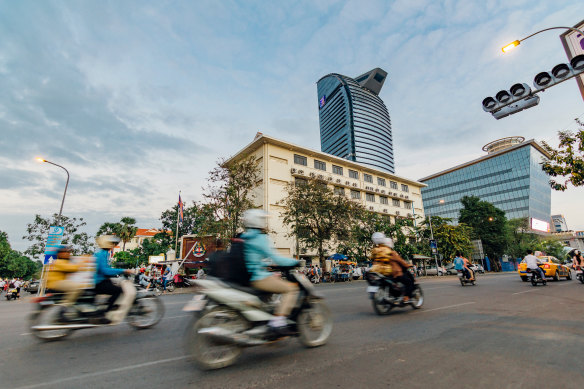
The formerly sleepy city buzzes at night.Credit: Adobe stock
Perhaps one indication of a city’s growing sophistication is the presence of craft brewing and independent spirit distillers – and Phnom Penh is no exception. The new Samai rum distillery on Street 830 opens its doors as a bar and for distillery tours on Thursday nights, with original cocktails concocted from the collection of handcrafted rums, including the sensational Kampot Pepper rum.
Back on the riverfront, there’s one quintessential Phnom Penh experience that has survived trends, economic growth and pandemics alike – dining on the communal mats at the open-air Night Market.
Bypass the crappy stalls selling fake designer handbags and go straight for the sizzling food stalls, where you can eat like royalty – albeit on the ground – for just a few dollars.
It’s a reminder that no matter how high a city soars, it’s in simple experiences like this that the heart and soul of its community is firmly rooted.
The writer travelled as a guest of Rosewood Phnom Penh.
The details
Fly
Air Asia flies from Sydney to Kuala Lumpur, then on to Phnom Penh in Cambodia. See airasia.com
Stay
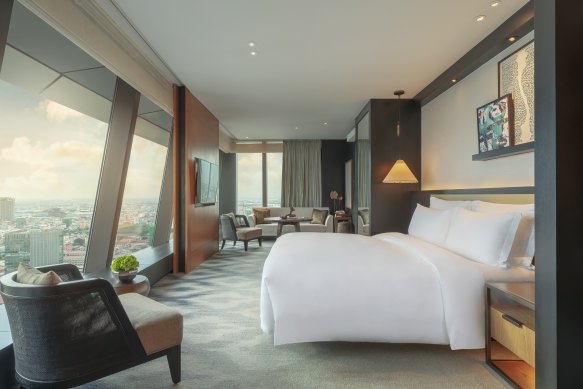
Rosewood Phnom Penh.Credit:
A three-night stay at Rosewood Phnom Penh is part of the 12-night Ultimate Luxury Tour of Cambodia. From $US12,900 ($19,060) for two people, with the Phnom Penh visit including three nights’ accommodation, daily breakfasts, a 30-minute massage at Sense, A Rosewood Spa, and a four-hour tuk tuk city tour. Package valid until October 31, 2024. See rosewoodhotels.com
Sign up for the Traveller Deals newsletter
Get exclusive travel deals delivered straight to your inbox. Sign up now.